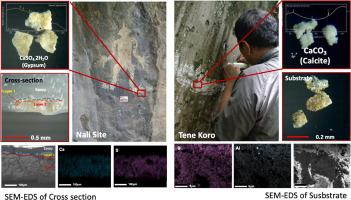Journal of Archaeological Science: Reports Pub Date : 2021-12-21 , DOI: 10.1016/j.jasrep.2021.103326 Moh. Mualliful Ilmi 1 , Evi Maryanti 1, 2 , Nadya Nurdini 1 , Pindi Setiawan 3 , Grandprix T.M. Kadja 1, 4 , Ismunandar 1

|
Nali and Tene Koro are Austronesian rock art sites located in Lembata, East Nusa Tenggara, Indonesia. At both sites, rock art images are painted on the surfaces of outcrop boulders. The rock art depicted at the Nali site is characterized by an anthropomorphic grayish-white image, while rock art at the Tene Koro site depicts a white boat equipped with an up-raked stern, a single mast, and a steering paddle. Since it was reported in 2018, information regarding the physicochemical properties of white pigments used at both sites remains unknown. Herein, a combined analytical strategy was employed to understand the physicochemical properties of the pigment used at the Nali and Tene Koro sites. Several characterization methods, including X-ray fluorescence (XRF), optical microscopy, secondary electron microscopy-energy dispersive X-ray spectroscopy (SEM-EDS), vibrational spectroscopy (Raman and FTIR), X-ray photoelectron spectroscopy (XPS), and thermal gravimetric-differential thermal analysis (TG-DTA), were applied. The results demonstrated that the white pigment at the Nali site consists of gypsum as a major component and other clay minerals incorporated as minor phases as part of the geological formation of gypsum. On the other hand, the white pigment from the Tene Koro site comprises calcite as the main constituent and minor amounts of sulfur-bearing minerals (gypsum) as calcite weathering products. To the best of our knowledge, this is the first report of a physicochemical study of white pigments used in rock art in Indonesia.
中文翻译:

印度尼西亚东努沙登加拉省 Lembata 的 Nali 和 Tene Koro 遗址的白色岩画颜料的物理化学特性的多分析研究
Nali 和 Tene Koro 是位于印度尼西亚东努沙登加拉的 Lembata 的南岛岩石艺术遗址。在这两个地点,岩石艺术图像都绘制在露头巨石的表面上。那里遗址所描绘的岩画以拟人化的灰白色形象为特征,而特内科罗遗址所描绘的岩画则描绘了一艘配备上倾斜船尾、单桅和舵的白色小船。自 2018 年报道以来,关于这两个地点使用的白色颜料的物理化学特性的信息仍然未知。在此,采用组合分析策略来了解 Nali 和 Tene Koro 站点使用的颜料的物理化学特性。几种表征方法,包括 X 射线荧光 (XRF)、光学显微镜、应用了二次电子显微镜 - 能量色散 X 射线光谱 (SEM-EDS)、振动光谱 (拉曼和 FTIR)、X 射线光电子能谱 (XPS) 和热重差热分析 (TG-DTA)。结果表明,那里遗址的白色颜料由作为主要成分的石膏和作为次要相掺入的其他粘土矿物组成,作为石膏地质形成的一部分。另一方面,来自 Tene Koro 遗址的白色颜料包含方解石作为主要成分和少量含硫矿物(石膏)作为方解石风化产物。据我们所知,这是印度尼西亚岩石艺术中使用的白色颜料的物理化学研究的第一份报告。和热重-差热分析(TG-DTA)。结果表明,那里遗址的白色颜料由作为主要成分的石膏和作为次要相掺入的其他粘土矿物组成,作为石膏地质形成的一部分。另一方面,来自 Tene Koro 遗址的白色颜料包含方解石作为主要成分和少量含硫矿物(石膏)作为方解石风化产物。据我们所知,这是印度尼西亚岩石艺术中使用的白色颜料的物理化学研究的第一份报告。和热重-差热分析(TG-DTA)。结果表明,那里遗址的白色颜料由作为主要成分的石膏和作为次要相掺入的其他粘土矿物组成,作为石膏地质形成的一部分。另一方面,来自 Tene Koro 遗址的白色颜料包含方解石作为主要成分和少量含硫矿物(石膏)作为方解石风化产物。据我们所知,这是印度尼西亚岩石艺术中使用的白色颜料的物理化学研究的第一份报告。结果表明,那里遗址的白色颜料由作为主要成分的石膏和作为次要相掺入的其他粘土矿物组成,作为石膏地质形成的一部分。另一方面,来自 Tene Koro 遗址的白色颜料包含方解石作为主要成分和少量含硫矿物(石膏)作为方解石风化产物。据我们所知,这是印度尼西亚岩石艺术中使用的白色颜料的物理化学研究的第一份报告。结果表明,那里遗址的白色颜料由作为主要成分的石膏和作为次要相掺入的其他粘土矿物组成,作为石膏地质形成的一部分。另一方面,来自 Tene Koro 遗址的白色颜料包含方解石作为主要成分和少量含硫矿物(石膏)作为方解石风化产物。据我们所知,这是印度尼西亚岩石艺术中使用的白色颜料的物理化学研究的第一份报告。











































 京公网安备 11010802027423号
京公网安备 11010802027423号